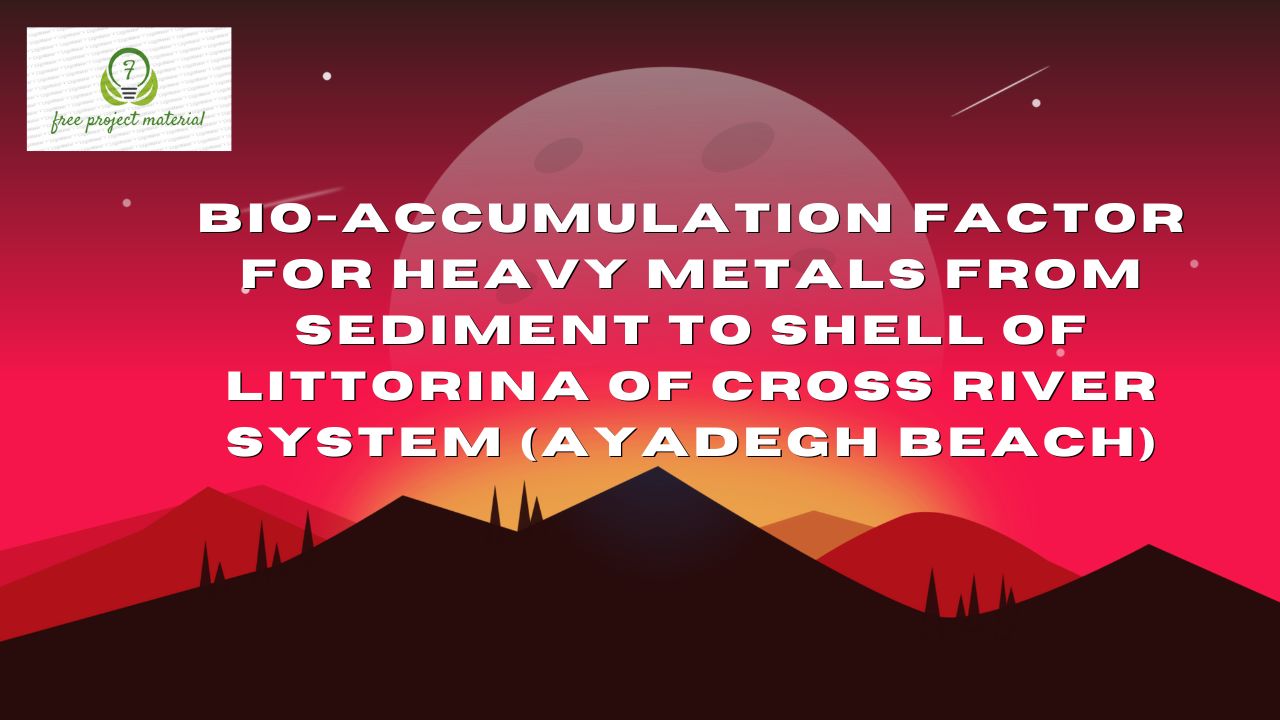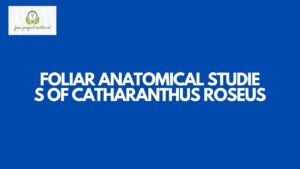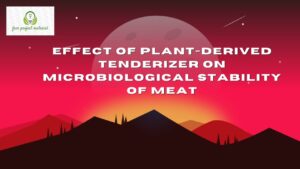ABSTRACTS
Analysis for bio-accumulation factor to know the absorption rate of certain trace metals from sediment to shell of Littorina littorea in Ayedeghe Beach. Sediment sample showed the sequence: Mg (27.07mg/kg) > Zn (10.99mg/kg) > Pb (3.21mg/kg) > (3.01mg/kg) > Cr (ND); the value for shell sample were Zn (2.3mg/kg) > Pb (0.78mg/kg) > Mg (0.41mg/kg) > Cd (0.09mg/kg) > Cr (ND). Sediment sample values were higher than the flesh sample values. Values for BAF were all below 1 indicating non-alarming status
TABLE OF CONTENTS
PAGES
TITLE PAGE – – – – – – – – i
CERTIFICATION – – – – – – – ii
DEDICATION – – – – – – – – iii
ACKNOWLEDGMENTS – – – – – – iv
ABSTRACTS – – – – – – – – v
TABLE OF CONTENTS – – – – – – – vi-viii
CHAPTER ONE
1.0 INTRODUCTION – – – – – – 1
1.1 Background of the Study – – – – – – 1-2
1.2 Aims and Objectives of the Study – – – – 2
1.3 Scope and Limitation of the Study – – – – 3
1.4 Significance of the Study – – – – – – 3
1.5 Definition of Terms – – – – – – 3-4
CHAPTER TWO
2.0 LITERATURE REVIEW
2.1 Description (morphology) of Littorina littorea – – 5-6
2.2 Habitat of Littorina – – – – – – 7
2.3 Feeding of Littorina – – – – – – 8-9
2.4 Life Cycle of Littorina – – – – – – 9-10
2.5 Environmental Requirement of Littorina – – 10-11
2.6 Ecological Value of Littorina – – – – – 11-13
2.7 Economic Value – – – – – – – 13
2.7.1 Arsenic (Ar) – – – – – – – 14
2.7.2 Lead (Pb) – – – – – – – – 14-15
2.7.3 Mercury (Hg) – – – – – – – 15-16
2.7.4 Cadmium (Cd) – – – – – – – 16-17
2.7.5 Chromium (Cr) – – – – – – 17-18
2.7.6 Aluminum (Al) – – – – – – 18-19
2.7.7 Iron (Fe) – – – – – – – – 19-20
CHAPTER THREE
3.0 MATERIALS AND METHODS
3.1 Materials – – – – – – – – 21
3.2 Methods – – – – – – – –
3.2.1 Study Area – – – – – – – – 21-22
3.2.2 Methodology – – – – – – – 22
3.2.3 Collection of Sample – – – – – – 22-23
3.2.4 Sample Preparation/Analysis – – – – – 23
CHAPTER FOUR
4.0 RESULT AND DISCUSSION
4.1 Result – – – – – – – – – 25-26
4.2 Discussion – – – – – – – – 26
CHAPTER FIVE
5.0 CONCLUSION AND RECOMMENDATIONS
5.1 Conclusion – – – – – – – – 29
5.2 Recommendations – – – – – – – 30
References
CHAPTER ONE
INTRODUCTION
1.1 The Background of the Study
Sediments have been reported to form the major reservoir of heavy metals in aquatic system while both natural and human influence could make the concentration of heavy metals in the water high enough to be of ecological significance (Akpan and Thompson, 2013). Bioaccumulation and enhancement is capable of leading to toxic level of these metals in fish, even when the exposure is low. Praveena et al., (2007) noted that accumulation of trace metals occurs in upper sediment in aquatic environments by biological and geochemical mechanism and become toxic to sediment inhibiting organism. Culminating in death, growth reduction and lower species diversity.
Cundah et al., (2009) reported that gastropod molluscs (Littorina littorea) fulfill all the requirement for environmental monitoring programmes of marine and brackish water pollution. These organism accumulated most of the contaminant particularly heavy metals at much higher levels than those found in water column.
Ayadeghe beach in the Cross River system like any other brackish ecosystem of the Niger Delta, is known to have Littorina littorea in abundance as common food delicacy of the areas which can also be used for animal feeds and as well as fertilizers formulations. This means that toxicity of the shell can expose organisms along the food chain to danger.
1.2 Aims and Objectives of the Study
- Determine the concentration of heavy metals both sediment and the shell of Littorina littorea.
- Compare the result from the two samples with the WHO standard.
- Determine the bio-accumulation factor from sediment to the shell of Littorina littorea.
- Determine the stability of Littorina littorea from the study area for consumption.
1.3 Scope and Limitation of the Study
This work is designed to investigate and assess the bioaccumulation factors of heavy metals from sediment to shell of L. littorea. Due to lack of time and financial constraint, this work is limited to only sediment and shell of L. littorea.
1.4 Significance of the Study
Ayadeghe beach is a popular catchment area for fish and periwinkle business. This study will show how safe is Littorina littorea for human consumption as well as providing data for future research work.
1.5 Definition of Terms
Bio-accumulation: is the gradual accumulation of substances, such as pesticides, or other chemicals in an organism. Bio-accumulation can occur when an organism absorbs a substance at a rate faster than that at which substance is lost by catabolism and excretion.
Heavy metals: are generally defined as metals with relatively high densities, atomic weights, or atomic numbers.
Sediments: is a solid materials that is moved and deposited in a new location. Sediment can consist of rocks and minerals, as well as the remains of plants and animals.
Digestion: is the breakdown of large molecules into small molecules so that they can be absorbed and used.
Trace metals: are the metals subset of trace elements; this is metals normally present in small but measureable amounts in animal and plant cells and tissues and that are necessary part of nutrition and physiology.
Anthropogenic activities: are the most important sources of metals to agricultural soil and contain metals in forms that are highly mobile and toxic to living organism.



